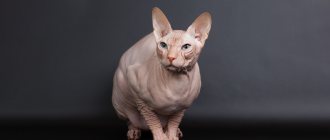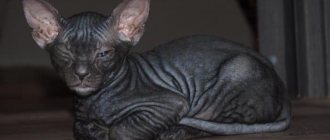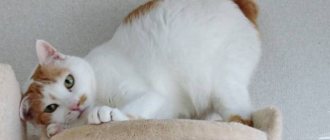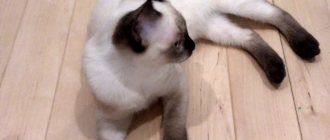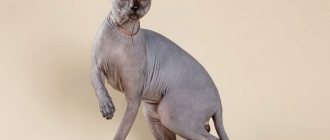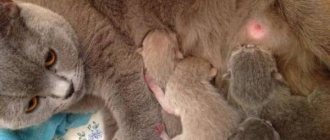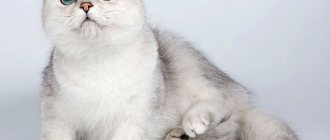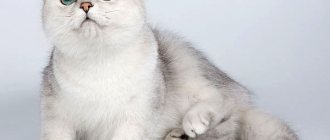History of the origin of the breed
The birthplace of the Don Sphinx is the Russian city of Rostov-on-Don. It is known that the kitten was found by university professor Elena Kovaleva. We can say that she simply saved the life of an animal that was being tortured by children. It looked like an ordinary cat, which she named Varvara. At home, she quickly settled in and came to her senses. And after a couple of months, she began to lose hair, which caused concern among the owner. After many examinations, the breeder came to the conclusion that hairlessness does not interfere with the baby’s life at all and does not bother her. The cause of hair loss was identified as a gene mutation. Having matured, Varvara brought offspring who completely adopted the genetic anomaly. Of all those born, only one cat was saved - Chita, who became the ancestor of the Don breed. The Don Sphynx cat breed received official status in 1996.
Nursery services
There are several “closed cats” in the nursery, which are used exclusively for mating with local cats. In order to use the services of one of these representatives, a mating agreement is concluded and it is quite expensive. The peculiarity of using nurseries is a 100% guarantee of obtaining healthy and purebred offspring, but for this you need to undergo a check, pass all the necessary tests and give the cat a manicure. Only after that the cat is invited to her.
Saving on mating can turn into a real disaster, which is not recommended. So, after saving on dates, you can get motherless offspring in the form of sick kittens that will have to be treated.
Daily procedures will cost a lot and will not guarantee the animals’ complete recovery. Such experiments can harm the cat itself, because untested cats can have a number of diseases that will be passed on to their offspring. Age will not play a role here, as well as many other features and characteristics.
Where to find a mate for your pet:
- according to the white list in nurseries;
- according to numerous advertisements on the Internet;
- at exhibitions that are held several times a year;
- in special clubs for cats, where this is stated in the rules.
Mating will depend on the title and breeding value of the cat. All necessary documents must be with the owner, who can provide them upon request.
https://youtube.com/watch?v=Jkx0h6pdNpk
Description of the breed
The Don Sphynx cat is not large in size, but at the same time has a muscular body with strong bones. These creatures are very pleasant and warm to the touch. Their body temperature is 38-40 C. In appearance, they are a wrinkled creature with an expressive gaze. Wrinkles can be observed on the face, paws and tail. The weight of the animal is about 3-5 kg for girls and 5-7 kg for boys. Like any breed, Don Sphynxes have a certain standard of appearance. Let's take a closer look at it.
Newborn Don Sphynx kittens have a certain peculiarity: after a couple of days of birth, they already open their eyes.
The head of the Don species is wedge-shaped, slightly rounded. The cheekbones and eyebrows are clearly visible on the muzzle. Vertical folds are clearly visible on the forehead. The nose is straight. The chin is harmoniously developed. The animal has large teeth. Long fangs can be seen from under the upper lip. The ears are set high and slightly rounded at the tip. The eyes are slightly slanted and almond-shaped, small in size. Eye color can be varied. There may be no mustache or eyebrows.
The body of a Don Sphynx cat is strong, muscular and proportional. Due to the difference in the width of the shoulders and hips, the body is pear-shaped. As for the limbs, the hind legs are longer than the front legs, proportional to the body and very long.
As for the skin, the Don species has three types:
- Naked or naked. Newborns have no fur, which is how they deserve their name. They are also called “rubber” because of the similar sensations when touching the skin.
- Velor or flock. The skin is covered with a thin fluff, it feels like velor fabric or peach peel. Whether the Don Sphynx will remain covered in velor or go bald will be decided by the age of two years.
- Brush (from the English “brush” - brush). Cats have coarse fur, more like bristles or fuzz. The Don Sphynx with fur has the ability to periodically lose it and then grow it again. This may be due to a number of reasons: changes in hormonal levels, pregnancy, changes in the season or diet, and other factors.
It is noteworthy that the Don Sphynx of the brush type is not represented in exhibitions. They are intended for breeding. The fact is that naked “dandelions” most often give birth to weak and non-viable offspring.
The color of the breed is recognized to be the most diverse: all colors and their combinations, as well as all types of patterns.
Preparing for the event
Sphynx pregnancy lasts about two months - from 60 to 70 days. During this time, you should get used to the idea of expanding your family and prepare for the event. There is no need to worry about the process itself. As a rule, females cope with everything themselves. Sphynx cats have very well developed maternal instincts, so if the cat is healthy and has not had any problems during pregnancy, trust her. But there are points that you should take care of.
Location requirements
Cats are independent creatures and love to spend time alone and in silence. And during the birth process, cats generally have a special mental state, so they need peace and privacy. It would be better if it was a separate, quiet room. But you can select a secluded corner and put a special cat house in it or build it from a large cardboard box.
The best option is if it opens from the top, but has a small hole on the side so that the cat can get out to eat and go to the toilet. This hole should be located at such a height that small kittens cannot then accidentally crawl out of the box. You need to lay something soft inside to make it warm and comfortable. But cover it with disposable diapers (can be purchased at any pharmacy or children's store). These diapers are very soft, absorb moisture well and are easy to change.
As soon as you notice that the pet has begun to worry, look for a secluded place and drag soft things there, place it in the house and stay with it, gently talking and stroking it. This way the animal will calm down and understand that there is no need to look for a place anymore.
Difference between the Canadian and Don Sphynx
The Canadian and Don Sphynxes are often confused with each other due to their similar appearance. In the comparative table of species and photos you can see what their similarities and differences are.
In addition to external differences, the most important thing is the genetic difference. The Canadian representative has a recessive gene, while the Don Sphynx has a dominant gene. In simple terms this means that the Canadian will always have more or less fur. The Don species can be born or become completely naked. These species cannot be crossed with each other.
Character and habits
The character of the Don pet is soft, affectionate and completely non-conflicting. The breed is sociable and friendly: both towards people and towards other pets. They are easy to train and adapt very well to their living conditions. However, litter box training can present some challenges.
As children, Don Sphynx babies are very playful and inquisitive. With age they become wiser and more balanced. This breed is not at all capable of aggression. She absolutely cannot stand loneliness: if you spend a long time outside the home, then you should not get a Sphynx. He may be very sad and even cry. You should not miss the fact that they are very touchy and are good at distinguishing the intonation in their voice. They are loyal to children and tolerate all their affection. If you decide to invite guests, then do not worry about the hospitality of the Don cat. They get along great and make contact with strangers.
As for the attitude towards the owner, it is impossible to describe: the Don Sphynxes feel his condition well and experience everything with him. They can hug your neck as support, thereby letting you know that you are not alone. You can notice that the Don breed can heal those places where it especially hurts; all this happens intuitively on a subconscious level. From the first minutes you feel their warmth and incredible lightness.
The Don Sphynx cat often chooses its owner. They love to cuddle or watch everything that happens somewhere from above. Do not forget that any pet’s character depends on its content and on the attitude of household members. As it is said in the work of Antoine de Saint-Exupéry: “We are responsible for those we have tamed.”
Process Features
The process itself consists of three stages:
- Contraction of the uterus: the vagina opens, minor discharge (mucus plug) and contractions may occur.
- Contractions become more frequent and stronger. The cervix is completely open and the fetus begins to move through the birth canal. Due to the pressure on the cervix, the cat strains to push the baby out as quickly as possible. The kitten may be born in a bladder if it does not rupture during birth. As a rule, the cat bursts the bubble itself and licks the kitten completely to open its airways and stimulate breathing. Variably, this can take from 10 minutes to an hour. If the stage has begun, more than an hour has passed, and the baby has not appeared, call the veterinarian.
- After the baby is born, the placenta comes out. After the cat licks the kitten and makes sure that everything is fine with it, it gnaws the umbilical cord and eats the placenta. At this stage, it is important to ensure that the placenta appears after each baby; if it gets stuck in the birth canal, this can lead to a dangerous infection. To be completely sure, if you are alone at the birth, it is better to write it down.
Something else interesting: How to properly prepare and match a cat with a cat
After the mother has taken care of the baby, she will push him towards the nipple. If this does not happen, you can apply it to the baby’s nipple yourself. Childbirth resumes. In between, the cat licks itself and rests. There are times when the process seems to be completed, and then after a few hours it resumes again.
Maintenance and care
Having no hair, the breed is very vulnerable. Don Sphynxes, like all hairless cats, need careful and daily care.
Complete or partial absence of hair does not guarantee the breed is hypoallergenic.
The living space should be warm and draft-free. If you still feel cool, then you shouldn’t risk it, but it’s better to dress your pet. In sunny weather, you should also wear clothes: when the sun's rays get on your skin, they can injure it.
The Don Sphynx sweats more profusely than other breeds. The secretion of the sebaceous glands is brownish in color with a characteristic odor. To avoid greasy stains on objects and bedding, wipe your pet with wet wipes every day. Wipes should be alcohol-free, suitable for children. You can also use a soft sponge and warm water. Pay special attention to skin folds, fingers, tail and groin area.
Regarding water procedures: they love them very much and are happy to swim. Procedures must be carried out at least once a week using special care products. After bathing, your pet should be dried thoroughly with a towel. If necessary, you can moisturize the skin with baby lotion or cream.
Due to the fact that Don breed cats do not have eyelashes, owners need to wipe their eyes daily. A decoction of chamomile or tea is suitable for this. The ears are cleaned as they become dirty using cotton pads and a special lotion, which can be purchased at a pet store or veterinary clinic. We do not recommend using cotton swabs so as not to damage the animal’s ear. Monitor the length of the nails: they are usually trimmed every 10 days.
Signs that it's about to start
A few days before giving birth, the cat begins to secrete colostrum from the swollen mammary glands. She often licks her genitals and may lose her appetite and refuse to eat. Body temperature decreases, as indicated by cold ears and nose.
Not only physical signs indicate an approaching birth. Behavior changes significantly. The cat sometimes tries to hide in a secluded place and begins to set up a maternity nest. If she has already met and accepted the house offered, she often climbs in and out of it. At times he follows the owner, caresses him, meows restlessly and calls for him.
The closer the time of birth approaches, the more intermittent her breathing becomes, she may lie with her hind legs stretched out limply. Well, of course, the surest sign is water and contractions.
Diet
Nutrition plays an important role in the content. Due to the complete or partial absence of fur, pets are forced to expend more energy and effort. Therefore, nutrition should be balanced and energy-intensive. At the same time, do not overdo it and follow the portion. “Dandelions” love to eat, which promises overeating and obesity.
Don cats can be fed both natural food and prepared food. When choosing industrial feed, it is important that it be from the same manufacturer and of high quality. When feeding natural food, the basis of the diet is: lean meat, sea fish, low-fat cottage cheese and other protein-rich foods. Be sure to give vegetables, fruits, and cereals. It is advisable to create an individual diet only after an individual consultation with a veterinarian. If the diet is chosen incorrectly, the animal can quickly develop serious problems with the intestines and stomach.
The nutrition of an adult Don pet and babies differs in many ways. Kittens have a very sensitive gastrointestinal tract, so they should be fed 3-4 times a day, preferably with wet food. More dense foods are introduced with caution and in small portions so as not to cause allergic reactions and intestinal imbalance.
As you know, Don representatives are partial to sweets, especially flour products. You need to be careful about this and try not to indulge in such delicacies. It is worth refraining from feeding the animal from the table: our food is too fatty and contains a lot of seasonings, which is very harmful to health.
When you need help
There are situations in which the cat cannot or does not have time to cope on its own (short interval between births). Therefore, you should be alert if:
- The release of amniotic fluid and the birth of the baby coincided. You must make sure that the baby does not choke: turn him upside down and shake him lightly. If he sneezed or sighed, everything is fine;
- the cat did not have time to free the kitten from the bubble. Tear it, carefully wipe the baby with a soft napkin or cloth, use a syringe or pipette to clean the nasal and oral cavities;
- the cat did not chew the umbilical cord. To avoid blood loss, tie the umbilical cord with a thread and cut it with scissors. Everything must be sterile;
- if the kitten is too weak and does not breathe normally. Perform very lightly (with gentle finger pressure) cardiac massage and artificial respiration;
- if the movement of the fetus is difficult or stuck. Lubricate your vagina with Vaseline oil. Make a loop from a soft napkin or cloth and slowly help pull the baby out while pushing;
- weak contractions. Consult your veterinarian and get a stimulation shot;
- In any unclear situation, call your doctor.
Health of the Don Sphynx
Thanks to the efforts of breeders, the Don Sphynx breed can boast of good health and endurance. However, they are susceptible to colds and skin problems.
Breed diseases
A Don compatriot has genetic diseases that are inherited:
- Inversion of the eyelids - eyelashes touch the eyeball, causing irritation and conjunctivitis;
- A shortened lower jaw is a discrepancy between the lower and upper jaws; doctors call this a malocclusion;
- Underdevelopment of the thymus - newborns live no more than 10 days, sudden sleep occurs;
- Nipple hyperplasia – the nipples increase in size and swell, which can be resolved surgically;
- The result of inadequate development of the skeletal system can be a curvature of the spine in the caudal region.
Lifespan
Before buying an animal, everyone thinks about how long the Don Sphynx lives? On average, life expectancy ranges from 12 to 15 years, but there have also been long-livers aged 18 years. It all depends on proper care and nutrition, as well as compliance with veterinary standards.
How much does it cost and how to choose a kitten
We recommend purchasing a Don kitten from breeders. Thus, you will protect yourself from buying a half-breed or an animal with possible defects.
You can find Don Sphynx nurseries in every big city or organize transportation of the animal. Upon purchase, you receive a veterinary passport, which must indicate all vaccinations performed. If you wish, you can ask to see the pedigrees of the parents to make sure the breed is purebred.
Play with your baby and see how active he is. Assess your general condition. Examine your pet: the eyes, ears, nose and anus should not have any discharge. It is important to know that a kitten should be purchased no earlier than 3 months. The older the animal, the easier it will be for him to get used to a new place.
On Avito, Don Sphynxes are sold at your own risk for up to $100 (2500-6000 rubles). On average, the price for a purebred Don kitten as a pet or, as it is also called, for castration (sterilization) varies between $180-300 (15,000-20,000 rubles). The price for kittens from show parents or for breeding starts from $450 (35,000 rubles). The cost is also influenced by the popularity of the nursery and the pedigree of the parents.
Colors
- black (nose black, like paw pads, skin slate gray);
- blue (light blue skin color with a silver tint, slate-colored nose, light gray paws);
- chocolate (nose and skin - all shades of chocolate, paw pads pinkish);
- lilac (silver with pale pink skin, nose and paws);
- white;
- cream (shades of pink);
- red (pink to bright red).
Bicolor: Any of the above with pure white. In this case, one ear should be painted over, preferably a bright spot on the top of the head.
Van: the cat is white, the tail is colored, there is a bright spot on the head that extends to the ears. The paws and nose are pale pink.
In the photo there are cats of the Canadian Sphynx breed, van and bicolor colors
Harlequin: a cross between a van and a bicolor. There is a spot on the top of the head, an ear catcher, a few spots on the body, and speckles on the legs and tail are allowed. Pink paw pads and nose.
Siamese color (color point): cream point, seal point, chocolate point, lynx point (tabby).
In the photo there is a cat of the Canadian Sphynx breed, Siamese color and harlequin
Tortoiseshell coloring can be observed in both cats and female cats (in the latter it is much more common). However, such a cat cannot be the father, since there is a genetic mutation.
Photos
Don Sphynx photo of kittens and cats:
